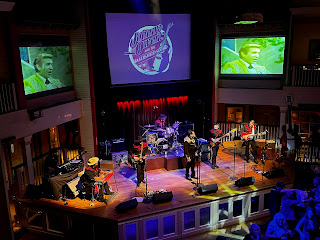It was Saturday, October 22, 2022, and we celebrated our 50th wedding anniversary; now, we’ve been married for 34 years - but we’ve heard the 50th is always special, so we celebrated in a very unusual way - in Bakersfield!
We had everything packed and ready for this year’s Yosemite adventure and decided to leave one day early. No reservations for the night, but oh well, we’re sure to find something. At around 5:00 p.m., we rolled into beautiful Bakersfield, CA. Yes, I’m being sarcastic. Not wanting to drive another three hours to Fresno and ready for dinner, we pulled off the freeway and found a room for the night.
“Well, what would you like to do for dinner?”
“Since we’re in Bakersfield, isn’t this where Buck Owens, the country-western singer-songwriter who helped establish the Bakersfield sound, lived and played Country music for many years? During our trip to Nashville, we never heard any country music. There must be some bar that plays live music. It is Saturday night!”
“Yes, there’s the Buck Owens Crystal Palace, but really - do you want to go there?” said Lori.
“We’ve never stopped here before; why not. It’s something we’ve never done.”
“Do you have reservations for dinner? Was the hostess’s first question? All of our tables are booked. However, if you are willing to climb two flights of stairs, we can seat you at a service counter.”
“Do I look that old?” I responded. Absolutely, whatever you have.”
By now, many of you are probably wondering, so what is the Bakersfield sound?
According to Wikipedia, the Bakersfield sound is a sub-genre of country music developed in the mid-to-late 1950s in and around Bakersfield, California. Bakersfield was the first sub-genre of country music significantly influenced by rock and roll, relying heavily on electric instrumentation and a strongly defined backbeat. It was also a reaction against the slickly produced, orchestra-laden Nashville sound, which was becoming popular in the late 1950s.
The Bakersfield sound became one of the most popular and influential country genres of the 1960s, initiating a revival of honky-tonk music and influencing later country rock and outlaw country musicians.
Wynn Stewart pioneered the Bakersfield sound while performing artists Buck Owens and Merle Haggard became two of the most successful artists of the original Bakersfield era while performing with The Buckaroos and The Strangers.
So for this year’s anniversary, we spent the evening with Johnny Owens and his band “The Bakersfield Sound.” Buck Owen’s youngest son played originals and many of the classic tunes from Waylon Jennings and Buck Owens. Buck Owens Crystal Palace is a living tribute to that bygone era.
I’m Patrick Ball; thanks for listening. I’ll see you in the next episode.

Comments